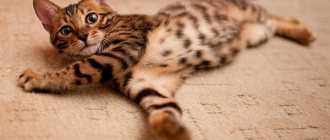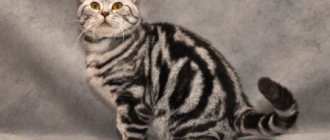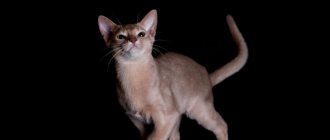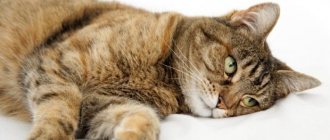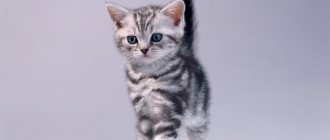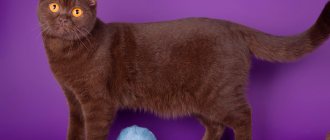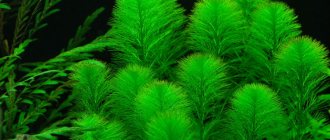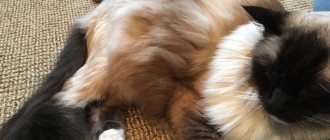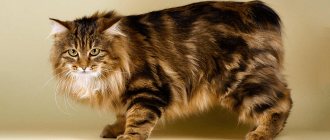Standard color requirements
The pattern on the coat of a short-haired cat must be clearly visible. Despite the variety of the pattern, it must contain the following elements, in addition to the ticked color:
- the eyeliner under the cat’s nose and eyes should match the “background” color;
- there should be light spots on the ears (one on each, on the outside);
- from one to two rows of spots on the abdomen;
- ring ornaments on the tail;
- "necklaces" on the neck;
- stripes on the limbs;
- a pattern similar to the “M” symbol on the forehead;
- clearly defined tabby pattern.
Photo of a British kitten - black golden spotted BRI ny 24
BRI ns 22 64 – black marble on silver
The reason the cat's color does not meet the requirements may be a mating where one of the animals was without a pattern.
The dominant factor in eye color is the basic tone of the animal's coat. More often it is required that the eyes be of copper shades - in blue and red Britons. Blue or green are also allowed - for silver and golden ones.
Bicolors
The coat color of these beautiful creatures has two colors, and a combination of white and any other shade is mandatory. Purebred bicolors must have a white belly, neck, chest, chin, limbs and, of course, muzzle.
Particolor (calico)
A Scottish cat of this type, called particolor, is a combination of white with tortoiseshell or spotted tabby color.
Harlequin
Harlequin captivated everyone with his unusual appearance. The cat is painted white (4/5 parts of the body), but the tail must be black, as well as the ears and the top of the head. The ventral part is white. The tip of the nose, like most people, is the same color – pink.
Wang
This breed only has colored tail, and sometimes has a few spots on the head. It happens that there are solid spots on the paws and back, but this is considered undesirable. When this breed develops red spots, it may also be called a Red Van.
Varieties of tabby
As mentioned above, tabby is divided into several varieties:
- marble;
- striped;
- spotted;
- ticked.
Each variety has a number: 22 – marble, 23 – maskerel, 24 – spotted, 25 – ticked, respectively, added at the end of the main encoding.
spotted | spotted
maskerel | striped
marble | marble
ticked | ticked
The British tabby color has light colors, and the pattern on the coat is dark colors: black, red, blue.
Tabby colors are divided into:
- BRI 22 | 23 | 24 | 25 – color points;
- BRI 22 | 23 | 24 | 25 – bicolor;
- golden BRI y 22 | 23 | 24 | 25 - golden tabby;
- silver BRI s 22 | 23 | 24 | 25 – silver tabby;
- cream BRI e 22 | 23 | 24 | 25 – cream tabby;
- red BRI d 22 | 23 | 24 | 25 – red tabby;
- fawn BRI p 22 | 23 | 24 | 25 - tabby fawn;
- cinnamon BRI o 22 | 23 | 24 | 25 - cinnamon tabby;
- chocolate BRI b 22 | 23 | 24 | 25 - chocolate tabby;
- blue BRI a 22 | 23 | 24 | 25 - blue tabby;
- brown BRI n 22 | 23 | 24 | 25 ‒ black | brown tabby;
- lilac BRI from 22 | 23 | 24 | 25 - lilac tabby.
British color point 24 and Scottish fold kitten
BRI ay 25 blue golden ticked
SFS 71 n 03 22 – Scottish Straight Black Marbled Bicolor
BRI bs 22 62 – chocolate marble on silver
Marble
Marble color is considered the most interesting and effective, among other variations. The Marbled Briton has two wide stripes on the back, from which radiate ring-shaped patterns filled in on the inside. The color, just like the others, must meet basic standards. It stands out from the rest in that the pattern on the wool represents a complete, complete picture without “breaks.” The pattern on the shoulder blades often resembles a butterfly, and striking stripes run from the corners of the eyes along the cheeks. The rings on the cat's neck must be closed, another irreplaceable feature of the merle color, and the quantity and price of the pet are directly related. If the pattern on the coat is not contrasting, then the color is considered defective. A marble pattern is visible on the kitten from the first days of life, and by two months it becomes bright and clearly visible.
The character of a British pet with a merle pattern is absolutely no different from the character of its counterparts with a different pattern; future owners are interested in this, since it seems that an animal of this color belongs to a different breed.
BRI d 22 - British Shorthair Red Marble
BRI f 22 – black tortoiseshell marble
Striped | brindle | whiskey
Striped | Markel coloring of British cats is quite rare, but is more common than marble. There are cases in which the striped pattern of the cub begins to be interrupted during growth, then the pattern begins to be classified as leopard.
The basic elements remain the same: circular stripes on the paws and neck, the letter "M" on the forehead, eyeliner in the same color. A tiger cat is distinguished, as one could understand from the subtitle, by contrasting stripes that run in a solid line from the back to the paws and should be quite narrow and often repeated, and the more often, the more the pet is valued. The full color is formed approximately 12 months after the kitten is born, which is rare among other color varieties. British tabby cats have golden or green eyes.
BRI ny 23
The basic elements remain the same: circular stripes on the paws and neck, the letter "M" on the forehead, eyeliner in the same color. A tiger cat is distinguished, as one could understand from the subtitle, by contrasting stripes that run in a solid line from the back to the paws and should be quite narrow and often repeated, and the more often, the more the pet is valued. The full color is formed approximately 12 months after the kitten is born, which is rare among other color varieties. British tabby cats have golden or green eyes.
Spotted | leopard print
Spotted colors | spotted tabby British cats are the most common and popular among cat lovers. Such offspring can arise from any tabby parents. A cat in this color resembles a leopard, which is the reason for the alternative name, and has all the characteristic features of a tabby: contrasting circles, stripes and rings, light spots on the ears. The spots of this color may not be the same as what people are used to, but represent dashed and dash-dotted lines. Without this, the spotted tabby color is impossible. Animals with spotted patterns may have sandy or green eyes.
BRI n 24 - British Longhair, black spotted
BRI q 24 – tortoiseshell spotted cinnamon
Plain (solid)
The color of Scottish Fold cats is monochromatic and they should not have any other color. The fold-eared cat can be of the following colors: white and black, chocolate and lilac, blue and red, cream, fawn and cinnamon. The most popular color in the world among solid Scottish cats is blue. These are the majority of cats.
White
The white Scottish Straight cat can have different eyes, from blue and bright orange to rich amber and copper. Kittens of this variety remain white for the rest of their lives. If kittens have spots, then an adult cat remains white for the rest of its life.
Black
The Scottish Fold black cat is mostly bright in color. A couple of white hairs are acceptable, but if the cat has large red and brown patches, then it is not a purebred.
Black Scottish Fold cats should be bright black in color and their ears, like all fold-eared cats, should be pressed to the head, unlike straight-eared cats. A straight-eared black cat always has its ears erect.
Chocolate
The chocolate Scottish Fold looks impressive. The chocolate color is quite rare. Brown fold kittens should have a smooth, uniform coat of chocolate color. The dark brown coloring adds nobility to the cat.
A brown cat gets this color if he has chocolate, chocolate bicolor or chocolate color points in his pedigree. Chocolate Scottish kittens always delight their owners. They look very cool against a light background.
Lilac (lavender)
A lilac long-eared cat gets this color if he has either lilac color points or lilac in his pedigree. The lilac coloration goes well with orange, copper or amber colored eyes and a light brown nose. This color is also called coffee with milk.
Blue color (blue)
The Scots Blue can have a coat color of many shades of blue. Some cats may have a fur color closer to gray, and some closer to blue. Each hair must be saturated, then the coat will be perfectly blue.
Ticked
Despite the fact that the ticked color belongs to the tabby cat colors, it has practically no pattern and looks like a solid color. The peculiarity is the brightness of the color of the main coat, and the upper part seems to be shaded. If you look closely, you will find that there are stripes on each hair. Of all the standard tabby color requirements, this color only has the letter "M" above the eyes and patterns on the face. If a ticked color has other main features of a tabby color, it will be rejected. This is a rather rare color subtype, because ticked males and females can produce kittens with any pattern on their coat.
BRI e 25 – cream ticked
BRI ny 25 – black gold ticked
Color point
The Color Point is a rare breed of Scottish cat with a color similar to that of a Siamese cat. In childhood they look a little like Thai kittens. The main background is white or cream. The muzzle, ears, paws and tail are painted in darker shades. Color point or links point have blue eyes.
They acquired their colors from their British ancestors, who had Persians with this shade in their family. By the way, it is very difficult to distinguish a British cat from a Scottish one, and even professionals cannot always do this.
Genetics of tabby color
Thanks for the patterned colors should be the agouti gene (A), responsible for the presence of the pattern, and the tabby gene (T), responsible for the nature of the pattern.
There are four genes in total:
- Ta – ticked;
- T – striped or spotted;
- tb – marble.
Dominance:
- Ta dominates over T and tb colors;
- T is dominant over tb color;
- tb – recessive color.
Formula:
- AA - tabby, such an animal will always produce offspring with patterns;
- Aa - tabby, this animal can produce kittens with or without a pattern;
- aa is an animal without patterns, the offspring from it, accordingly, will also be monochromatic.
Spotted tabby (leopard)
With the help of the tabby gene and a set of polygenes, which seem to break the patterns on the cat’s body, a spotted color is formed. The spots contrast with the main color of the animal and are clearly defined, do not merge or intersect. The striped color becomes mottled even with little exposure to polygenes. This explains why spotted cats are much more common. The merle color is not so afraid of the effects of polygenes, because it will be considered spotted only if it is completely divided into clear spots of small sizes. By the pattern on the coat, it is most often noticeable from what color the spots were formed.
BSH n 24
Classic, blotched | marble tabby
It is a form of the tabby gene (tb). It is distinguished by its extraordinary beauty and rarity. The drawing is rich and contrasting. The butterfly-like pattern on the shoulder blades is one of the main distinguishing features. There are wide stripes along the ridge of the animal, and expressive large spots adorn the sides. It has a modification of marble, characterized in that it has a less pronounced middle and pronounced edges.
Red marble BRI d 22
brown tabby BRI n 22
Black marble silver ns 22
silver tabby BRI ns 22 64
Tiger, maskerel tabby (tiger)
This type of pattern is rare among tabby cats, but not as rare as merle. From head to tail there is a straight wide line, from which frequent, unbroken narrow stripes extend. The stripes tend to tear and then the tiger color turns into leopard, which is the reason for the rarity of the striped variety. Formed using the T gene.
Ticked tabby
The Ta genome is formed, which is dominant among all others. With this color there are practically no patterns, and the entire body is covered with ticked (striped) hairs. Despite the dominance of the gene, it is quite rare, being a gift from the Abyssinian breed, which does not currently exist. The value of this color is the intensity of the main tone of the animal’s coat and the undercoat of pleasant delicate shades.
BLH ns 25
ds 25 red silver ticked
Disadvantages of tabby color: “torn”, unclear and asymmetrical pattern, absence or non-closed rings on the neck. For light-colored animals, a brown or grayish undercoat color is unacceptable.
Eyes: Shades of orange or emerald eye color are acceptable, based on the basic tone of the British cat.
"Silver" and "gold" tabby
If you pay enough attention to the background, and not just the pattern, then the patterns on the wool take on a beautiful appearance. With the help of additional polygenes, you can give the undercoat a copper tone. Add a golden and unusual hue. And if you influence the pattern with the Silver gene, the tone will change to a pronounced pearl color and become silver.
Cons: There are many requirements for the golden and silver shade of the undercoat. So “gold” should have a color without any admixtures of brown and gray, and “silver” should have no yellow tint. The yellow discoloration that most often appears on the nose, paws and chest is called ruffism. It has been observed that breeds in which the fine “gold” silver contains rufisms, and in the pedigree with good “silver” the “gold” has an inappropriate undercoat color.
Eyes: “gold” must have green shades of eyes, “silver”, in addition to green, may have orange.
Moire or drawing?
When the Aguti gene does not have the proper effect on color, the cat's color becomes flat and without a pattern. The pattern on such cats is visible as moiré, despite the fact that at birth it was quite contrasting. A similar effect is observed in lion cubs and cubs of other feline species. There is a pattern in the genotype of any cat, but in order for it to appear, the influence of the Aguti gene is necessary.
Disadvantages: the disadvantages of cats without a pattern are the features of their patterned counterparts - incomplete moire, uneven coloring of the coat along the entire length. In adult cats, moire should be absent.
Eye color: copper, others are not acceptable.
There are polygenes that eliminate moire, because of this the moire pattern becomes either completely invisible or too bright, which misleads breeders. The cat appears to be tabby in color, which is not the case.
Distinguishing a pattern from a moire pattern is not as difficult as it seems. In tabby, the patterns are bright and contrasting, while in moire, they differ from the main type of coat by only a few tones.
SFL n 22 03
BRI h 22 – chocolate tortoise marble
Maintenance and care
The Scots are not picky about their care and do not require large expenditures. These are homebody cats who don’t mind spending their entire lives in a city apartment. They do not require regular walking, but will accept a leash if desired. They get used to the tray quite quickly and do not get capricious over little things. Basic care consists of:
- Choosing the right diet
- Necessary cat equipment: bed, tray, bowls, scratching posts, toys, hygiene items
- Choosing a place for your pet to rest, which should be located in a quiet and safe place
- Combing once a month with a furminator
- Brushing your teeth with a silicone brush once a week
Care is expressed in regular care of the pet’s health, healthy nutrition and fun games
- If desired, you can trim your nails with a nail clipper, no more than once every three weeks.
- Treating your pet's eyes and ears with a wet wipe
- Mandatory routine vaccination and treatment against parasites
- Visits to the veterinarian for preventive examinations every six months
Diseases
Prevention of deworming - from 1-2 times a year to 1 time every 4 months (depending on the situation). If a cat eats meat, i.e. the risk of infection is high - worms should be removed once a quarter. This is also done before vaccination. Suitable drugs: Milbemax for cats, Drontal plus, Cestal, Praziquantel.
When buying a kitten from a cattery, you can be sure that it will be fully vaccinated. You will monitor the remaining vaccinations yourself and do them annually. Mandatory vaccinations: against rabies, panleukopenia, calicivirus, herpes virus infection). This disease can be brought not only from an infected animal, but even on shoes from the street. Suitable vaccine: Purevax (French).
Photo of an Asian tabby cat
Optional vaccinations: against viral peritonitis, leukemia, chlamydia and immunodeficiency. They are worth doing if your pet is at increased risk of infection. Suitable vaccine: Purevax RCPCh, Purevax FelV (French).
Are you taking your tabby to the country? Be sure to vaccinate him against ringworm (lichen). Domestic vaccines - Polivak, Microderm - will do an excellent job of protecting your pet from this unpleasant disease. However, vaccination will not be superfluous even for a cat that sits at home and does not go outside (there are known cases of infection through clothes and shoes).
If you do not plan to breed, spay or neuter the animal. This way it will not suffer from the influence of sex hormones.
If you notice that your pet has become lethargic, refuses water and food, or sleeps poorly (not to mention such obvious signs of illness as vomiting, nosebleeds, drowsiness, and restlessness), consult a doctor immediately.
Diseases can be divided into several groups:
- parasitic (fleas, ear mites, worms);
- infectious (rabies, respiratory diseases, panleukopenia);
- skin (ringworm, dermatitis);
- pathologies of internal organs and systems (pyelonephritis, urolithiasis, diabetes, myocarditis, myocardosis, gastritis, colitis);
- eye diseases (conjunctivitis, blepharitis, prolapse of the third eyelid);
- ear diseases (otitis media, abscess);
- gynecological diseases (uterine torsion or hernia, vaginitis);
- pathologies of the musculoskeletal system (arthrosis, arthritis).
The sooner treatment begins, the easier it will be to cope with the disease. Neglected diseases become chronic.
Expert opinion
Dusheba Vera Ivanovna
In 2010, she graduated from the Moscow State Academy of Veterinary Medicine named after K.I. Scriabin with honors, specializing in veterinary medicine. I regularly attend veterinary conferences, congresses, and webinars.
When planning to buy a tabby kitten, remember: in Russia few people breed this breed. Therefore, do not take risks and do not turn to private sellers in an attempt to save time or money: this is a risky undertaking and most often such maneuvers do not live up to expectations. The baby should have clean ears and eyes, without purulent discharge or wounds, a pink tongue and gums, and fresh breath from the mouth. Ask to see documents: birth certificate, pedigree, veterinary passport and green card (if you plan to purchase abroad). Approximate cost of a kitten: 50-70 thousand rubles.
Advantages and disadvantages
The Scottish cat breed has its pros and cons, which, however, does not in any way affect the popularity of their representatives around the world. Among the advantages we note:
- Amenability
- Calm
- Accuracy
- Attractive appearance
- Lack of aggression
- Undemanding
Scottish cats will perform well in families with children and in the company of older people.
Among the disadvantages are:
- Independence
- Not inclined to learn
- They don't like water
- Can be stubborn
In conclusion, we note that Scottish dogs quickly adapt to new living conditions and show minimal care requirements. They are soft, obedient and accommodating, but at the same time they love solitude and quiet time. In this case, you can always reach a compromise and give the animal the right to choose.
Rules for choosing a kitten
You should buy a kitten at the age of 3-4 months, this will allow you to avoid making a mistake in choosing a color for those who are looking for a marbled Scotsman. You should focus on a specialized nursery, whose breeders have been doing their business for a long time, have many good reviews and a license to breed the breed. As a rule, such people are not prone to deception, since they greatly value the reputation they have accumulated over the years.
The kitten acquires its “signature” color by the age of three months, but to be completely convinced of its quality, you should look at the entire litter and the parents
An experienced breeder can provide certificates confirming the health of the parents and their offspring, and he will not refuse to demonstrate the conditions in which he keeps his pets.
The kitten itself must be well-groomed and healthy. His eyes, nose and ears should be clean, his belly well-fed, and his fur combed, without lumps or debris in the hairs. The kitten should be curious, playful and not shy.
